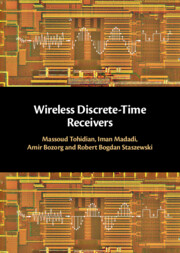3 - Discrete-Time High-Order Low-Pass Filter
Published online by Cambridge University Press: 05 May 2022
Summary
One of the main building blocks in a receiver is a low-pass filter (LPF) used at the baseband. This block is responsible for selecting the desired channel. In zero-IF receivers, this block is placed directly after the RF downconversion mixer. In a high-IF receiver,the LPF is required after a second downconversion from the IF to baseband. In addition to wireless communication applications, integrated LPFs are the key building blocks in various other types of applications, such as hard disk drive readchannels,videosignalprocessing,smoothingfilteringinaDAC,andantialiasingfilteringbeforea sampling system. The noise of these filters is one of the key system-level concerns. This noise can be usually traded off with the total filter capacitance and, consequently, total power and area. Therefore, for a given system-level noise budget, a filter with a lower noise coefficient reduces the area and power consumption. On the other hand, the linearity of the filter should be high enough to maintain the fidelity of the wanted signal.
Keywords
- Type
- Chapter
- Information
- Wireless Discrete-Time Receivers , pp. 55 - 86Publisher: Cambridge University PressPrint publication year: 2022



